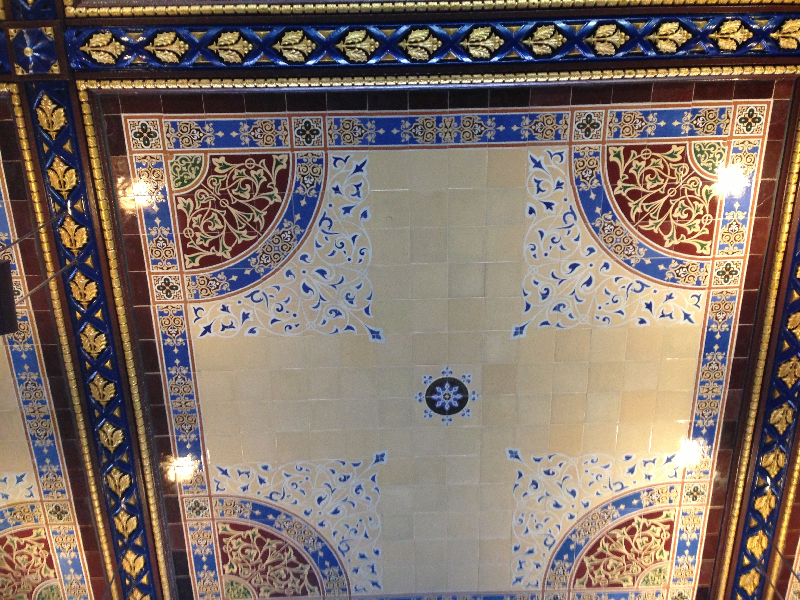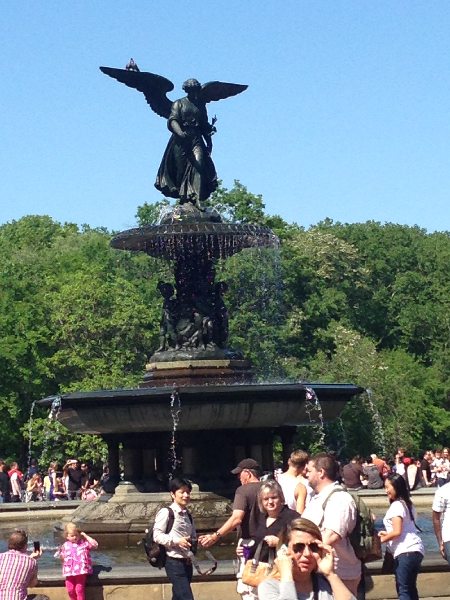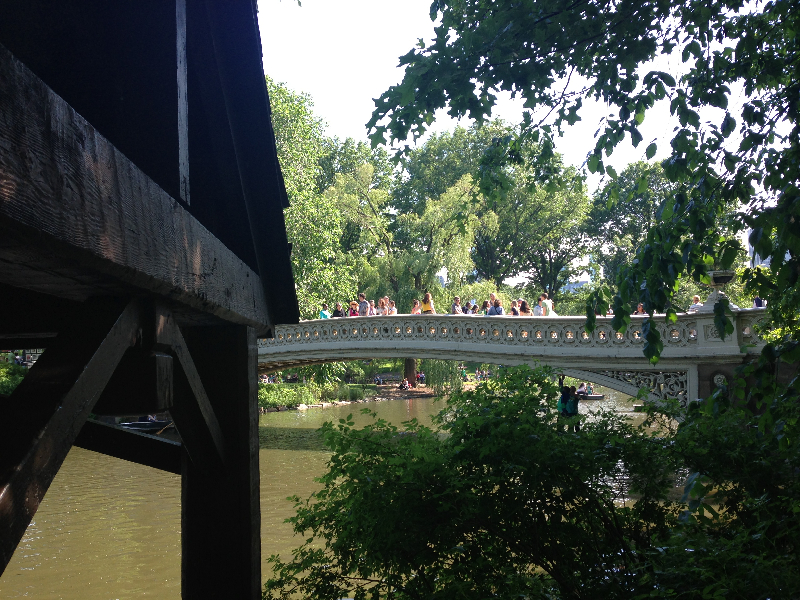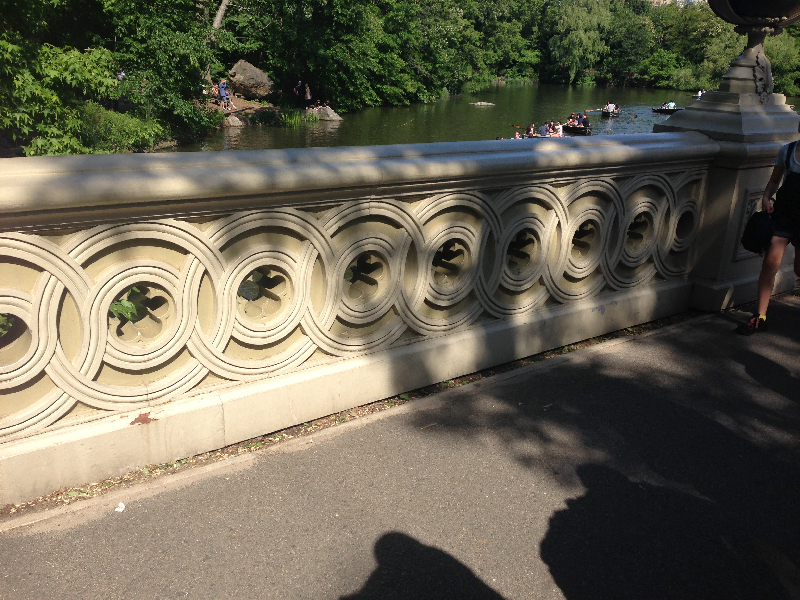On this very blustery, cool New York day, I started with a walking tour of the Jewish Upper West Side with Marty Shore and the Lower East Side Jewish Conservancy.
My favorite fun fact was more generic than Jewish. Did you know that tenements are five stories and “French Flats” are six stories? Well, that explains a lot. Tenements were built to make the most money off of immigrants. Cramming four apartments per floor, the residents shared two toilets per floor, and each apartment only had 2 windows. One of those windows might be from the bedroom overlooking the kitchen. What a view! No wonder TB was known as the “Jewish disease.” By 1901, a new law was passed requiring each room to have a window. French Flats benefit from the extra light, sanitation, and ventilation. Of course, tenement apartments on the Lower East Side sell for a fortune now, as I’m sure they do on the Upper West Side. Times do change.
My favorite architecture came from the Belnord apartments, which could mean ‘beautiful north’, with a little creative spelling of the French equivalent. Built by John Jacob Astor, the apartments are huge, through-floors, meaning they stretch from the street to the courtyard. Here’s a view into the courtyard.

The building stretches an entire city block from W 86th to W 85th and from Broadway to Amsterdam, but only has 221 apartments. Doesn’t that give you an idea of the scale of the apartments?
Isaac Bashevis Singer, Zero Mostel, and Lee Strasberg all lived there. I bet the halls rocked!


Maybe you can make out the fresco like painted cement of the archways.
A very classy place. We were chased off by the white-gloved doorman.
On the flip side was Seneca Village, formed by free blacks, poor Irish immigrants, and even some middle class types, based on the bone china found in a recent archeological dig. They built their own houses in the 1850s on land that would become Central Park and were summarily kicked out of their homes, with 24 hours notice and without recompense, to make way for the park. Perhaps you can imagine the wooden houses they built when you stand at Central Park West and 83rd Street.
Then I jumped off the tour and took the crosstown bus over to the Met, where members were getting a sneak peak at The Civil War and American Art. As a museum colleague, I talked my way in. I had seen the exhibit at the Smithsonian American Art Museum in Washington, so wanted to see how the exhibit was laid out, as well as to take a close look at two paintings. I heard the podcasts of Eleanor Harvey, Curator at the American Art Museum, talk about five works from the show, so was anxious to see some details for myself on these very famous paintings.
First, Winslow Homer’s A Visit from the Old Mistress, a powerful warhorse from 1876, one of several incredibly poignant and provocative works he made during Reconstruction. Click on this image to enlarge it, to see the particular detail Harvey talked about.

The former owner of these slaves has visited their cabin to ask for a favor, for them to work for her perhaps. Originally, Homer painted the white woman’s hand by her heart, holding a red flower. A peace offering? The sign of an open heart? Whatever it might mean, Homer changed his mind and painted it out, removing all sentimentality. Instead, the white woman confronts and is confronted by the black women in a tense, cold stand off. Pentimento, the leaching through of layers of color over time, is a major issue with Homer’s less technically accomplished, earlier works, which allows us a glimpse into his thought process and provides a truly fascinating, new perspective on the work.
Same with Harvey’s reading of Eastman Johnson’s The Girl I Left Behind from c1872. I don’t know if clicking to enlarge this image will even help with this enchanting detail.

This girl, who’s loose hair is whipped back by winds like we had today, holds books and seems to be a school girl, gazing dreamily into her future in this Reconstruction era. But Harvey points out that she wears a wedding band. All of a sudden, the title takes on two levels of meaning. Her husband (now more likely than a father or brother) has left her to go fight. And the girl left behind could represent America herself. The America before the war. The figure stands in the middle of the painting bisecting the landscape, ambiguous and devastated by war, marked only by another detail.
In the lower right corner of the background landscape, which her front foot points toward, is a split rail fence. That particular kind of fence was an emblem of Abraham Lincoln. Her stance and position in the painting, plus that ring, makes her the re-unifier of North and South, now that Lincoln was gone. She becomes the allegorical figure of America, generally represented by a woman, her wind whipped by physical and economic violence and turmoil of war and its aftermath. The painting is immediately elevated from the sentimental to an image for all time. Can you tell I’m in love?
Another really insightful show has opened at the Whitney. Hopper Drawing focuses on the artist process. Any one gallery of the exhibit features one or two Hopper paintings and many of the sketches and drawings that evolved into the painted work.
My head was going all over the place. Since Hopper’s work is considered cinematic, I spent a lot of time thinking about the depiction of film in painting. Hopper painted this familiar scene, the inside of the movie house in 1939 with New York Movie.

The wall text talks about how the usherette is depicted in a militaristic uniform, with its jaunty red stripe. The movie house rules prohibit her from watching the movie. Notice that the audience is made of up one-sies, people on their own. Now compare that image to this exuberant painting by John Sloan, Movies – Five Cents, from 1907 (not in the Whitney show).

Movies in 1907 are still a spectacle. The theater is thronged, and the film is a shared, captivating experience. Note the young woman in her be-scarfed hat, turned to look back at us. Looks like she might have saved a seat. How the tone of the American Urban Realism painting changed in those 30 years. Hopper infuses the work with his trademark isolation and loneliness. Sloan is all about the energy.
So is Reginald Marsh, who made his own movie palace painting. But I’m not going to give that away. Come on my tour at the New York Historical Society this summer, and you’ll get to see it and his other awesome New York scenes for yourself.
Back to the Whitney and film, David Hockney has a video there called Jugglers. It’s delightful. Made up of 18 screens, slightly akilter, ordinary people are juggling and hoola-hooping, and sometimes making a mess of it. All color and fragmented and reassembled bodies, it’s just great good fun.

My museum hopping ended with the new shows at the National Academy. On this blustery day, I was especially drawn into the world of Pat Steir, whose coloristic drip paintings evoke very quiet waterfalls. Here’s her 2005 Blue River, which takes up a whole, long wall. The details are delicious, so painterly. I sat and enjoyed this peaceful waterscape, a respite from the windy world of art and architecture.










































